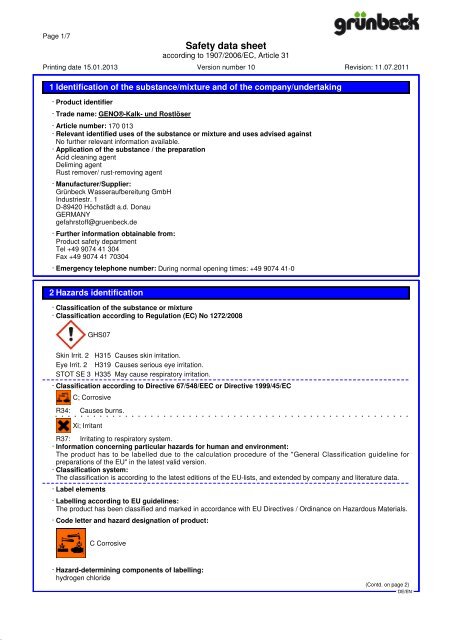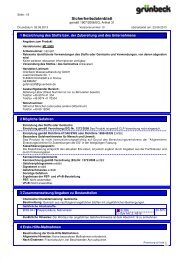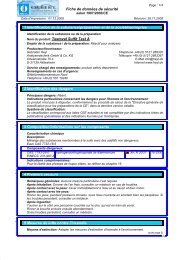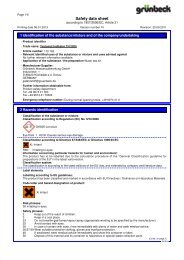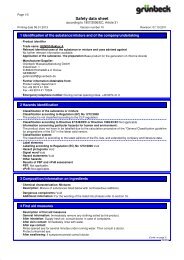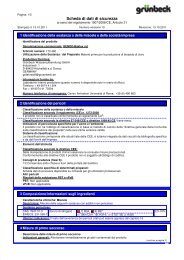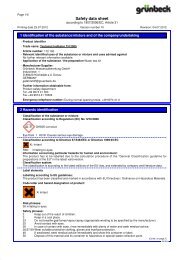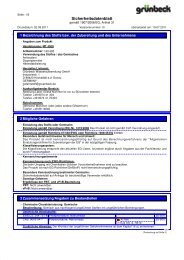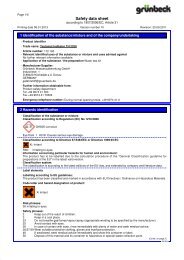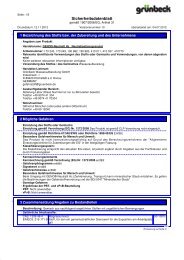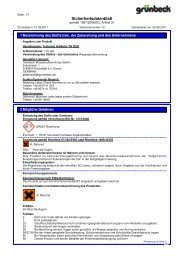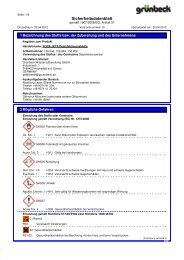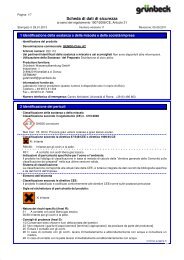SDB GENO-Kalk- und Rostlöser EN - Grünbeck Wasseraufbereitung ...
SDB GENO-Kalk- und Rostlöser EN - Grünbeck Wasseraufbereitung ...
SDB GENO-Kalk- und Rostlöser EN - Grünbeck Wasseraufbereitung ...
You also want an ePaper? Increase the reach of your titles
YUMPU automatically turns print PDFs into web optimized ePapers that Google loves.
35.0.5<br />
Page 1/7<br />
Safety data sheet<br />
according to 1907/2006/EC, Article 31<br />
Printing date 15.01.2013 Version number 10<br />
Revision: 11.07.2011<br />
1 Identification of the substance/mixture and of the company/<strong>und</strong>ertaking<br />
· Product identifier<br />
· Trade name: <strong>G<strong>EN</strong>O</strong>®-<strong>Kalk</strong>- <strong>und</strong> <strong>Rostlöser</strong><br />
· Article number: 170 013<br />
· Relevant identified uses of the substance or mixture and uses advised against<br />
No further relevant information available.<br />
· Application of the substance / the preparation<br />
Acid cleaning agent<br />
Deliming agent<br />
Rust remover/ rust-removing agent<br />
· Manufacturer/Supplier:<br />
<strong>Grünbeck</strong> <strong>Wasseraufbereitung</strong> GmbH<br />
Industriestr. 1<br />
D-89420 Höchstädt a.d. Donau<br />
GERMANY<br />
gefahrstoff@gruenbeck.de<br />
· Further information obtainable from:<br />
Product safety department<br />
Tel +49 9074 41 304<br />
Fax +49 9074 41 70304<br />
· Emergency telephone number: During normal opening times: +49 9074 41-0<br />
2 Hazards identification<br />
· Classification of the substance or mixture<br />
· Classification according to Regulation (EC) No 1272/2008<br />
GHS07<br />
Skin Irrit. 2 H315 Causes skin irritation.<br />
Eye Irrit. 2 H319 Causes serious eye irritation.<br />
STOT SE 3 H335 May cause respiratory irritation.<br />
· Classification according to Directive 67/548/EEC or Directive 1999/45/EC<br />
C; Corrosive<br />
R34: Causes burns.<br />
Xi; Irritant<br />
R37: Irritating to respiratory system.<br />
· Information concerning particular hazards for human and environment:<br />
The product has to be labelled due to the calculation procedure of the "General Classification guideline for<br />
preparations of the EU" in the latest valid version.<br />
· Classification system:<br />
The classification is according to the latest editions of the EU-lists, and extended by company and literature data.<br />
· Label elements<br />
· Labelling according to EU guidelines:<br />
The product has been classified and marked in accordance with EU Directives / Ordinance on Hazardous Materials.<br />
· Code letter and hazard designation of product:<br />
C Corrosive<br />
· Hazard-determining components of labelling:<br />
hydrogen chloride<br />
(Contd. on page 2)<br />
DE/<strong>EN</strong>
35.0.5<br />
Page 2/7<br />
Safety data sheet<br />
according to 1907/2006/EC, Article 31<br />
Printing date 15.01.2013 Version number 10<br />
Revision: 11.07.2011<br />
Trade name: <strong>G<strong>EN</strong>O</strong>®-<strong>Kalk</strong>- <strong>und</strong> <strong>Rostlöser</strong><br />
· Risk phrases:<br />
34 Causes burns.<br />
37 Irritating to respiratory system.<br />
(Contd. of page 1)<br />
· Safety phrases:<br />
1/2 Keep locked up and out of the reach of children.<br />
9 Keep container in a well-ventilated place.<br />
13 Keep away from food, drink and animal feedingstuffs.<br />
26 In case of contact with eyes, rinse immediately with plenty of water and seek medical advice.<br />
29/56 Do not empty into drains, dispose of this material and its container at hazardous or special waste<br />
collection point.<br />
36/37/39 Wear suitable protective clothing, gloves and eye/face protection.<br />
45 In case of accident or if you feel unwell, seek medical advice immediately (show the label where possible).<br />
63 In case of accident by inhalation: remove casualty to fresh air and keep at rest.<br />
· Other hazards<br />
· Results of PBT and vPvB assessment<br />
· PBT: Not applicable.<br />
· vPvB: Not applicable.<br />
3 Composition/information on ingredients<br />
· Chemical characterization: Mixtures<br />
· Description: Mixture of substances listed below with nonhazardous additions.<br />
· Dangerous components:<br />
CAS: 7647-01-0<br />
EINECS: 231-595-7<br />
CAS: 107-19-7<br />
EINECS: 203-471-2<br />
hydrogen chloride<br />
C R34; Xi R37<br />
Skin Corr. 1B, H314; STOT SE 3, H335<br />
prop-2-yn-1-ol<br />
T R23/24/25; C R34; N R51/53<br />
R10<br />
Flam. Liq. 3, H226; Acute Tox. 3, H301; Acute Tox. 3, H311; Acute Tox. 3,<br />
H331; Skin Corr. 1B, H314; Aquatic Chronic 2, H411<br />
· Additional information: For the wording of the listed risk phrases refer to section 16.<br />
4 First aid measures<br />
· Description of first aid measures<br />
· General information: Immediately remove any clothing soiled by the product.<br />
· After inhalation: In case of unconsciousness place patient stably in side position for transportation.<br />
· After skin contact: Immediately wash with water and soap and rinse thoroughly.<br />
· After eye contact: Rinse opened eye for several minutes <strong>und</strong>er running water. Then consult a doctor.<br />
· After swallowing: Drink plenty of water and provide fresh air. Call for a doctor immediately.<br />
· Information for doctor:<br />
· Most important symptoms and effects, both acute and delayed No further relevant information available.<br />
· Indication of any immediate medical attention and special treatment needed<br />
No further relevant information available.<br />
5 Firefighting measures<br />
· Extinguishing media<br />
· Suitable extinguishing agents:<br />
CO2, powder or water spray. Fight larger fires with water spray or alcohol resistant foam.<br />
· Special hazards arising from the substance or mixture No further relevant information available.<br />
· Advice for firefighters<br />
· Protective equipment: No special measures required.<br />
6 Accidental release measures<br />
· Personal precautions, protective equipment and emergency procedures<br />
Wear protective equipment. Keep unprotected persons away.<br />
10-25%<br />
≤ 2,5%<br />
(Contd. on page 3)<br />
DE/<strong>EN</strong>
35.0.5<br />
Page 3/7<br />
Safety data sheet<br />
according to 1907/2006/EC, Article 31<br />
Printing date 15.01.2013 Version number 10<br />
Revision: 11.07.2011<br />
Trade name: <strong>G<strong>EN</strong>O</strong>®-<strong>Kalk</strong>- <strong>und</strong> <strong>Rostlöser</strong><br />
· Environmental precautions:<br />
Do not allow product to reach sewage system or any water course.<br />
Inform respective authorities in case of seepage into water course or sewage system.<br />
Do not allow to enter sewers/ surface or gro<strong>und</strong> water.<br />
· Methods and material for containment and cleaning up:<br />
Absorb with liquid-binding material (sand, diatomite, acid binders, universal binders, sawdust).<br />
Use neutralizing agent.<br />
Dispose contaminated material as waste according to item 13.<br />
Ensure adequate ventilation.<br />
· Reference to other sections<br />
See Section 7 for information on safe handling.<br />
See Section 8 for information on personal protection equipment.<br />
See Section 13 for disposal information.<br />
7 Handling and storage<br />
· Handling:<br />
· Precautions for safe handling<br />
Ensure good ventilation/exhaustion at the workplace.<br />
Prevent formation of aerosols.<br />
· Information about fire - and explosion protection: No special measures required.<br />
· Conditions for safe storage, including any incompatibilities<br />
· Storage:<br />
· Requirements to be met by storerooms and receptacles: Store only in the original receptacle.<br />
· Information about storage in one common storage facility: Not required.<br />
· Further information about storage conditions:<br />
Keep container tightly sealed.<br />
Store in cool, dry conditions in well sealed receptacles.<br />
· Storage class: 8 B<br />
· Specific end use(s) No further relevant information available.<br />
8 Exposure controls/personal protection<br />
· Additional information about design of technical facilities: No further data; see item 7.<br />
· Control parameters<br />
· Ingredients with limit values that require monitoring at the workplace:<br />
7647-01-0 hydrogen chloride<br />
AGW (Germany) 3 mg/m³, 2 ppm<br />
2(I);DFG, EU, Y<br />
107-19-7 prop-2-yn-1-ol<br />
AGW (Germany) 4,7 mg/m³, 2 ppm<br />
2(I);DFG, H<br />
· Additional information: The lists valid during the making were used as basis.<br />
(Contd. of page 2)<br />
· Exposure controls<br />
· Personal protective equipment:<br />
· General protective and hygienic measures:<br />
Keep away from foodstuffs, beverages and feed.<br />
Immediately remove all soiled and contaminated clothing<br />
Wash hands before breaks and at the end of work.<br />
Avoid contact with the eyes and skin.<br />
· Respiratory protection:<br />
In case of brief exposure or low pollution use respiratory filter device. In case of intensive or longer exposure use<br />
self-contained respiratory protective device.<br />
· Protection of hands:<br />
Protective gloves<br />
The glove material has to be impermeable and resistant to the product/ the substance/ the preparation.<br />
(Contd. on page 4)<br />
DE/<strong>EN</strong>
35.0.5<br />
Page 4/7<br />
Safety data sheet<br />
according to 1907/2006/EC, Article 31<br />
Printing date 15.01.2013 Version number 10<br />
Revision: 11.07.2011<br />
Trade name: <strong>G<strong>EN</strong>O</strong>®-<strong>Kalk</strong>- <strong>und</strong> <strong>Rostlöser</strong><br />
(Contd. of page 3)<br />
Selection of the glove material on consideration of the penetration times, rates of diffusion and the degradation<br />
· Material of gloves<br />
The selection of the suitable gloves does not only depend on the material, but also on further marks of quality and<br />
varies from manufacturer to manufacturer. As the product is a preparation of several substances, the resistance of<br />
the glove material can not be calculated in advance and has therefore to be checked prior to the application.<br />
· Penetration time of glove material<br />
The exact break through time has to be fo<strong>und</strong> out by the manufacturer of the protective gloves and has to be<br />
observed.<br />
· For the permanent contact gloves made of the following materials are suitable: PVC gloves<br />
· Eye protection:<br />
Tightly sealed goggles<br />
9 Physical and chemical properties<br />
· Information on basic physical and chemical properties<br />
· General Information<br />
· Appearance:<br />
Form: Fluid<br />
Colour: Yellowish<br />
· Odour: Characteristic<br />
· pH-value at 20°C: < 0,5<br />
· Change in condition<br />
Melting point/Melting range: Undetermined.<br />
Boiling point/Boiling range: ca. 85-108°C<br />
· Flash point: Not applicable.<br />
· Self-igniting: Product is not selfigniting.<br />
· Danger of explosion: Product does not present an explosion hazard.<br />
· Vapour pressure at 20°C: 20 hPa<br />
· Density at 20°C: ca. 1,114 g/cm³<br />
· Solubility in / Miscibility with<br />
water: Fully miscible.<br />
· Solvent content:<br />
Organic solvents: 0,0 %<br />
VOC (EC) 0,03 %<br />
· Other information No further relevant information available.<br />
10 Stability and reactivity<br />
· Reactivity<br />
· Chemical stability<br />
· Thermal decomposition / conditions to be avoided: No decomposition if used according to specifications.<br />
· Possibility of hazardous reactions No dangerous reactions known.<br />
· Conditions to avoid No further relevant information available.<br />
· Incompatible materials: No further relevant information available.<br />
· Hazardous decomposition products: Hydrogen chloride (HCl)<br />
11 Toxicological information<br />
· Information on toxicological effects<br />
· Acute toxicity:<br />
· Primary irritant effect:<br />
· on the skin: Caustic effect on skin and mucous membranes.<br />
(Contd. on page 5)<br />
DE/<strong>EN</strong>
35.0.5<br />
Page 5/7<br />
Safety data sheet<br />
according to 1907/2006/EC, Article 31<br />
Printing date 15.01.2013 Version number 10<br />
Revision: 11.07.2011<br />
Trade name: <strong>G<strong>EN</strong>O</strong>®-<strong>Kalk</strong>- <strong>und</strong> <strong>Rostlöser</strong><br />
(Contd. of page 4)<br />
· on the eye: Strong caustic effect.<br />
· Sensitization: No sensitizing effects known.<br />
· Additional toxicological information:<br />
The product shows the following dangers according to the calculation method of the General EU Classification<br />
Guidelines for Preparations as issued in the latest version:<br />
Corrosive<br />
Irritant<br />
Swallowing will lead to a strong caustic effect on mouth and throat and to the danger of perforation of esophagus<br />
and stomach.<br />
12 Ecological information<br />
· Toxicity<br />
· Aquatic toxicity: No further relevant information available.<br />
· Persistence and degradability No further relevant information available.<br />
· Behaviour in environmental systems:<br />
· Bioaccumulative potential No further relevant information available.<br />
· Mobility in soil No further relevant information available.<br />
· Additional ecological information:<br />
· General notes:<br />
Water hazard class 1 (German Regulation) (Self-assessment): slightly hazardous for water<br />
Do not allow <strong>und</strong>iluted product or large quantities of it to reach gro<strong>und</strong> water, water course or sewage system.<br />
Must not reach sewage water or drainage ditch <strong>und</strong>iluted or unneutralized.<br />
· Results of PBT and vPvB assessment<br />
· PBT: Not applicable.<br />
· vPvB: Not applicable.<br />
· Other adverse effects No further relevant information available.<br />
13 Disposal considerations<br />
· Waste treatment methods<br />
· Recommendation<br />
Must not be disposed together with household garbage. Do not allow product to reach sewage system.<br />
· Uncleaned packaging:<br />
· Recommendation: Disposal must be made according to official regulations.<br />
14 Transport information<br />
· UN-Number<br />
· ADR, IMDG, IATA UN1789<br />
· UN proper shipping name<br />
· ADR 1789 HYDROCHLORIC ACID<br />
· IMDG, IATA HYDROCHLORIC ACID<br />
· Transport hazard class(es)<br />
· ADR, IMDG, IATA<br />
· Class 8 Corrosive substances.<br />
· Label 8<br />
· Packing group<br />
· ADR, IMDG, IATA III<br />
· Environmental hazards:<br />
· Marine pollutant: No<br />
· Special precautions for user Warning: Corrosive substances.<br />
(Contd. on page 6)<br />
DE/<strong>EN</strong>
35.0.5<br />
Page 6/7<br />
Safety data sheet<br />
according to 1907/2006/EC, Article 31<br />
Printing date 15.01.2013 Version number 10<br />
Revision: 11.07.2011<br />
Trade name: <strong>G<strong>EN</strong>O</strong>®-<strong>Kalk</strong>- <strong>und</strong> <strong>Rostlöser</strong><br />
· Danger code (Kemler): 80<br />
· EMS Number: F-A,S-B<br />
· Segregation groups Hypochlorites<br />
· Transport in bulk according to Annex II of<br />
MARPOL73/78 and the IBC Code Not applicable.<br />
· Transport/Additional information:<br />
· ADR<br />
· Tunnel restriction code E<br />
· UN "Model Regulation": UN1789, HYDROCHLORIC ACID, 8, III<br />
15 Regulatory information<br />
· Safety, health and environmental regulations/legislation specific for the substance or mixture<br />
(Contd. of page 5)<br />
· Labelling according to EU guidelines:<br />
The product has been classified and marked in accordance with EU Directives / Ordinance on Hazardous Materials.<br />
· Code letter and hazard designation of product:<br />
C Corrosive<br />
· Hazard-determining components of labelling:<br />
hydrogen chloride<br />
· Risk phrases:<br />
34 Causes burns.<br />
37 Irritating to respiratory system.<br />
· Safety phrases:<br />
1/2 Keep locked up and out of the reach of children.<br />
9 Keep container in a well-ventilated place.<br />
13 Keep away from food, drink and animal feedingstuffs.<br />
26 In case of contact with eyes, rinse immediately with plenty of water and seek medical advice.<br />
29/56 Do not empty into drains, dispose of this material and its container at hazardous or special waste<br />
collection point.<br />
36/37/39 Wear suitable protective clothing, gloves and eye/face protection.<br />
45 In case of accident or if you feel unwell, seek medical advice immediately (show the label where possible).<br />
63 In case of accident by inhalation: remove casualty to fresh air and keep at rest.<br />
· Chemical safety assessment: A Chemical Safety Assessment has not been carried out.<br />
16 Other information<br />
This information is based on our present knowledge. However, this shall not constitute a guarantee for any specific<br />
product features and shall not establish a legally valid contractual relationship.<br />
· Relevant phrases<br />
H226 Flammable liquid and vapour.<br />
H301 Toxic if swallowed.<br />
H311 Toxic in contact with skin.<br />
H314 Causes severe skin burns and eye damage.<br />
H331 Toxic if inhaled.<br />
H335 May cause respiratory irritation.<br />
H411 Toxic to aquatic life with long lasting effects.<br />
R10 Flammable.<br />
R23/24/25 Toxic by inhalation, in contact with skin and if swallowed.<br />
R34 Causes burns.<br />
R37 Irritating to respiratory system.<br />
R51/53 Toxic to aquatic organisms, may cause long-term adverse effects in the aquatic environment.<br />
· Department issuing MSDS: Laboratory<br />
· Contact: Mrs. Gerstmeier<br />
(Contd. on page 7)<br />
DE/<strong>EN</strong>
35.0.5<br />
Page 7/7<br />
Safety data sheet<br />
according to 1907/2006/EC, Article 31<br />
Printing date 15.01.2013 Version number 10<br />
Revision: 11.07.2011<br />
Trade name: <strong>G<strong>EN</strong>O</strong>®-<strong>Kalk</strong>- <strong>und</strong> <strong>Rostlöser</strong><br />
(Contd. of page 6)<br />
· Abbreviations and acronyms:<br />
RID: Règlement international concernant le transport des marchandises dangereuses par chemin de fer (Regulations Concerning the International<br />
Transport of Dangerous Goods by Rail)<br />
ICAO: International Civil Aviation Organization<br />
ADR: Accord européen sur le transport des marchandises dangereuses par Route (European Agreement concerning the International Carriage of<br />
Dangerous Goods by Road)<br />
IMDG: International Maritime Code for Dangerous Goods<br />
IATA: International Air Transport Association<br />
GHS: Globally Harmonized System of Classification and Labelling of Chemicals<br />
VOC: Volatile Organic Compo<strong>und</strong>s (USA, EU)<br />
DE/<strong>EN</strong>


